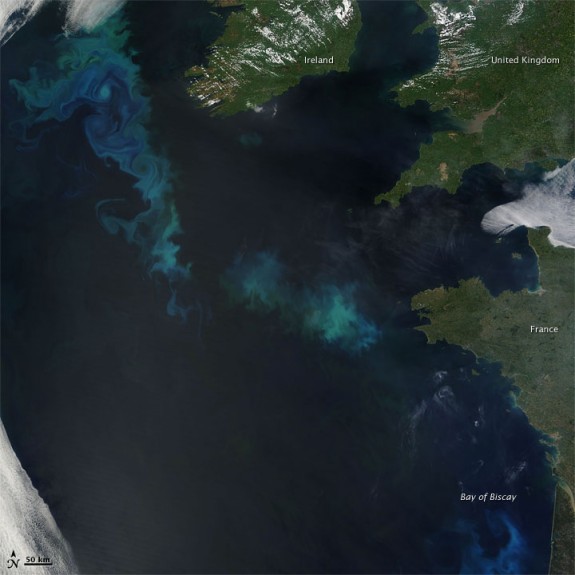To Increase Salmon Populations, Company Dumped 110 Tons of Iron Into the Pacific Ocean
Adding iron to the ocean can make life bloom, but scientists are uneasy about the potential unknown consequences

A phytoplankton bloom in the North Atlantic. Photo: Terra – MODIS / NASA Earth Observatory
About 180 miles off the coast of Haida Gawaii, an archipelago on the western shores of British Columbia, Canada, the Haida Salmon Restoration Corporation decided to dump 110 tons of an iron-based compound into the Pacific waters, says the CBC. The dump was part of a $2 million bid to drive a surge in salmon populations and is currently under investigation by Environment Canada’s enforcement branch.
The project was pitched to local residents as a way to trigger a bloom in phytoplankton through the iron fertilization effect, says APTN. Many regions of the ocean don’t have enough iron to support all of the life that could otherwise exist, so just like adding fertilizer to the soil, adding iron to the ocean can cause a temporary boom in productivity. More iron leads to more phytoplankton, which in turn could lead to more salmon. Phytoplankton blooms also have the potential to draw carbon dioxide out of the atmosphere. According to The Guardian,
Satellite images appear to confirm the claim by Californian Russ George that the iron has spawned an artificial plankton bloom as large as 10,000 square kilometres. The intention is for the plankton to absorb carbon dioxide and then sink to the ocean bed – a geoengineering technique known as ocean fertilisation that he hopes will net lucrative carbon credits.
Though small-scale iron fertilization trials have been carried out in the past, they were designed to help scientists understand how the process works and to seek out any unintended consequences. The new dump, on the other hand, has scientists worried because of its sheer scale. As The Guardian points out, the iron dump could violate a United Nations moratorium on large-scale iron fertilization projects. On Deep Sea News, Craig McClain details the history of the people behind the controversial event.
The CBC says that “the project is ringing alarm bells in the scientific community, because the bloom it created spread 10,000 square kilometres and was visible from space.” Maite Maldonado, speaking to the CBC, said that the commercialized dump is 100 times larger than any previous iron fertilization experiment. She said that “the process could have effects that are the reverse of those intended, as the lack of oxygen could potentially create toxic, lifeless waters.”
More from Smithsonian.com:
Is Geoengineering the Answer to Climate Change?
Phytoplankton: The “Biggest” Little Guys in the Ocean
/https://tf-cmsv2-smithsonianmag-media.s3.amazonaws.com/accounts/headshot/smartnews-colin-schultz-240.jpg)
/https://tf-cmsv2-smithsonianmag-media.s3.amazonaws.com/accounts/headshot/smartnews-colin-schultz-240.jpg)